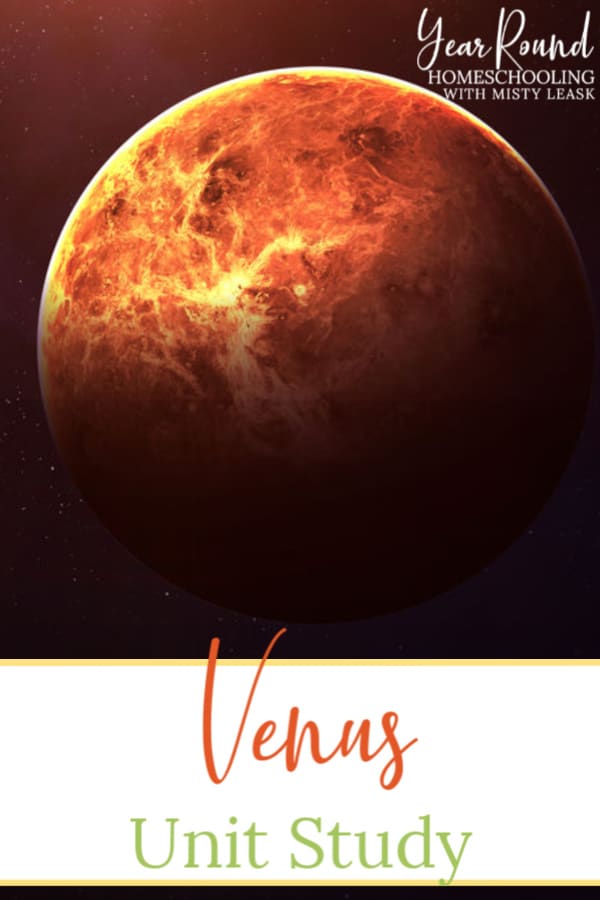It is likely that you have seen Venus in the sky many times without even realizing it! Your kids will enjoy learning Venus’ nicknames, its topography, size and much more through this Planet Venus Unit Study.

Science isn’t always a child’s favorite subject, but the solar system can make it a bit more fun! Grab a blanket and spend time together outside gazing into the night sky to inspire them to want to learn about what they see.
Taking time to teach and learn alongside your kids is one of the biggest blessings and opportunities that a homeschool mom has. Enjoy discovering new things as you study the planet Venus together!
Planet Venus Unit Study
Venus
Our closest neighbor in the solar system is Venus and the planet is referred to as ‘Earth’s sister’ due to the similarities of the two planets.
Venus, a terrestrial planet, is the brightest object in the night sky after the Sun and Moon.
Since Venus rotates in the opposite direction of most planets, East to West, one day-night on Venus is equal to 117 days on Earth.
On Venus, one day-night cycle takes 117 Earth days because Venus rotates in the direction opposite of its orbital revolution around the Sun.
Venus has both volcanoes and mountains with Maxwell Montes being the planet’s highest mountain at 20,000 feet high.
On Jan. 31. 2019 a Japanese spacecraft, Akatsuki, discovered a giant streak among the clouds on Venus.
- Name
The planet Venus was named after the Roman goddess of love and beauty. It’s nicknames are ‘The Morning Star’ and ‘The Evening Star’ because it rises and sets each day.
- Size
Venus is the 6th largest planet in the solar system. It is similar in size to Earth.
-
- Radius
The radius of Venus is 3,760 miles. To determine a planet’s radius you measure the distance from the center of the planet to the edge of the planet.
-
- Diameter
Figuring out the diameter of a planet is easy once you know its radius. Simply take the radius and multiply it times two. By doing so, you’ll find that Venus’ diameter is 7,520 miles.
-
- Mass
Venus’ mass comes in at 4,870,000,000 trillion metric tons, making it the 3rd most massive planet in our solar system. Weight and mass can be confusing, so be sure not to confuse them. You measure mass by how much matter an object has within it.
-
- Volume
The volume of Venus is 222,738,686,740miles3 . It is a bit more challenging to find the volume of Venus than its diameter or mass. To find Venus’ volume you’ll need this mathematical formula, V = 4/3 pi x r^3, and the planet’s radius.
-
- Surface area
Venus has a surface area of 177,697,463 square miles. In order to find the surface area you have to determine how many square units it will take to exactly cover the surface of a sphere. You’ll need this formula to determine Venus’ surface area, (or any sphere) on your own.
-
- Density
With a density of 5.243 g/cm³, Venus is the 3rd densest planet in the solar system.
- Location in the Solar System
Venus is the 2nd planet from the Sun.
- Distance from the Sun
The planet Venus is always moving, just like the rest of the planets in our solar system, but on average it is 67,391,286 miles from the Sun.
- Light time from the Sun
It takes 6.03 minutes for the light from the Sun to reach Venus.
- Layers
The planet Venus has three layers. The iron core has a 2,000 mile radius, followed by a mantle of hot rock and the surface is made of an always moving thin layer of rock. Consider. Why is Venus’ surface always moving?
- Temperature
Venus is the hottest planet with temperatures reaching 880+ degrees Fahrenheit. Its coolest temperatures are found on top of Maxwell Montes, Venus’ highest mountain with an average temperature of 715 degrees Fahrenheit.
- Speed
The planet Venus travels at 78,339 miles per hour. Do the math! How many miles does Venus travel in one 24 hour day on Earth?
- Orbit
Venus orbits the Sun in 225 Earth days — nearly a year on Earth!
- Axis Rotation
It takes Venus 243 days on Earth to complete a rotation on its axis making it the slowest rotating planet in our solar system.
- Atmosphere
Venus has a thick atmosphere that is made up of mostly carbon dioxide. It is because of its atmosphere that Venus is the hottest planet even though it isn’t the closest planet to the Sun. The heat from the Sun gets trapped in Venus’ atmosphere creating a greenhouse effect.
Please note, that some of the resources below may include evolutionary information. I encourage you to have a conversation with your children or preview these resources prior to assigning them as part of your homeschool studies.
Articles
Literature
 VenusShop on Amazon
VenusShop on Amazon Venus: Planets in Our Solar...Shop on Amazon
Venus: Planets in Our Solar...Shop on Amazon Are We There Yet? All About...Shop on Amazon
Are We There Yet? All About...Shop on Amazon Venus (21st Century Junior ...Shop on Amazon
Venus (21st Century Junior ...Shop on Amazon Why is Venus Called "The Ev...Shop on Amazon
Why is Venus Called "The Ev...Shop on Amazon
Videos
Art
Crafts
Games and Activities
Paper Plate Earth and Venus Activity
Printables
Food
Venus Rice Krispie Treat Snack
What did your kids enjoy learning the most through your Venus unit study?

